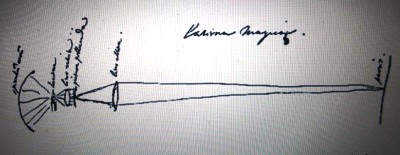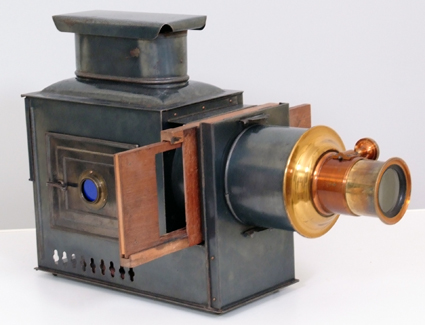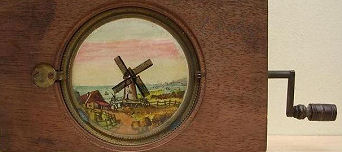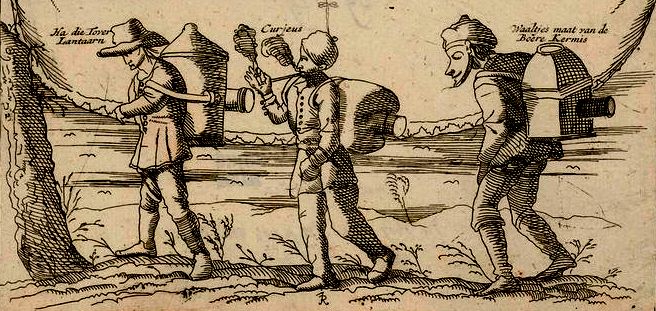|
LICHTBENDE AND THE MAGIC LANTERN |
|
|
LICHTBENDE AND THE MAGIC LANTERN Lichtbende uses the magic lantern in a special way. You can see how the players create this world. The magic lanterns are installed right in front of the big screen so everyone can see what the performers do with the magic lanterns and other projectors. The result of all their actions is enlarged and visible on the big screen. Lichtbende doesn't use traditional magic lantern slides but instead they use daily life objects and materials like bottles, plastic cutlery, beads, buttons, yarn, bubble plastic etc. We use these small objects of daily life to create minipuppets or other objects that we can move in the magic lantern, the slide- or overheadprojector. Manipulating these objects is like a marionette show but then with very small movements. Everything is projected on a big screen bringing the figures to life the way a puppetplayer brings his puppets to life. Because the projection lens in the magic lantern mirrors the images all figures and objects must be manipulated in the magic lantern upside down and mirrored. Music adds another layer of life; the shows are without text. You hear live tuba, trombone, clarinet, flute, saxophone, street organ and homemade instruments. "During our edcuational projects with kids we disovered how exciting it is to build landscapes by using recycle materials in our projections and to bring daily objects to life. Especially on kids' faces we saw the wonder on their faces when they discovered that you can create a whole castle from a candy wrapper. Our experience is that children interpret even the most abstract projection images without any effort and place these images in a narrative. |

Lichtbende also uses small handheld magic lanterns
that are easy to move. This is an old Japanese technique. The magic
lantern landed in Japan through business routes between the two
countries and
formed the beginning of the animé. |
|
THE HISTORY OF THE MAGIC LANTERN |
|
|
A long time ago there was no film or video, no television and no movie theatres. Back then people watched magic lantern performances together.
THE MAGIC LANTERN
The oldest magic lantern had a
candle or oil lamp as a lightsource, a lantern plate and a projection lens.
CHRISTIAAN HUYGENS Inventor of the magic lantern. He was a prominent mathematician, fysicist and astronomist from the Dutch Golden Age. He experimented with lenses, microscopes and telescopes and invented many scientific instruments. He also wrote early sciencefiction. Christiaan didn't think the magic lantern fitted in with his status as a serious and prominent scientist. At that time he would never have expected the huge impact the lantern would eventually have, with film and beamers still working according to the same principle. Christiaan Huygens' father worked at the French royal court and brougght the magic lantern to the attention of the French Sun King. The lantern was used there to entertain the king and his family and to perform small scalle shows for the elite.
|
A sketch of the magic lantern with 2 lenses, by Christiaan Huygens, 1694. From left to right: hollow mirror, lamp, glass lens, transparent slide, other lens on the wall.
Huygens had already accomplished to produce a simple movement effect by showing two images in a fast sequence: a skeleton that takes of his hat in the next picture. Dance of the dead, following the example of Hans Holbein 1659. |
|
LANTERN SLIDES At first glass slides with hand painted pictures on it were used in the magic lantern. These slides were produced by the magic lantern player (also called the 'lanternist'). But later also the instrument makers and optical specialists, the ones who made magic lanterns and sold them, painted the accompanying pictures themselves. Later Artists were trained specifically to paint the slides at companies. It was a delicate task, because even the smalles mistakes would be enlarged on the screen and therefore highly visible. Later a kind of slide with a litographic print was pressed on the glass. Eventually this was replaced by photography. The picture was printed directly on the glass and after that often hand colored with waterpaint or inkt
|
  By moving the slides back and forth movement of the arm is created.
|
|
THE MAGIC LANTERN SHOW Until the second part of the 18th century the magic lantern was mainly used by scientists. Later in the 19th century regular people could watch magic lantern shows at the annual fair. These special shows were performed by 'Luikerwalen', those were travelling magic lantern players and narrators from Luik in Wallonia (Belgium). They discovered that it was an easy way to provide information. In that time illiteracy was still high among regular people. The magic lantern was therefore used to educate in all kinds of ways. Eventually performances were hold in a private circle of family and friends.
SITES AND SOURCES |
|
|
|
|

.jpeg)







